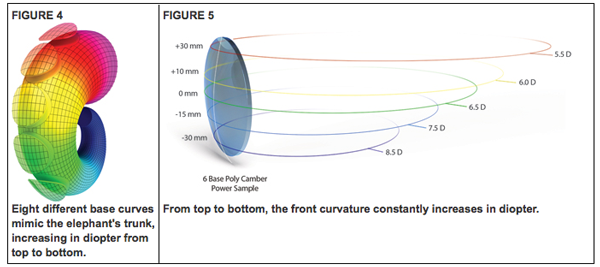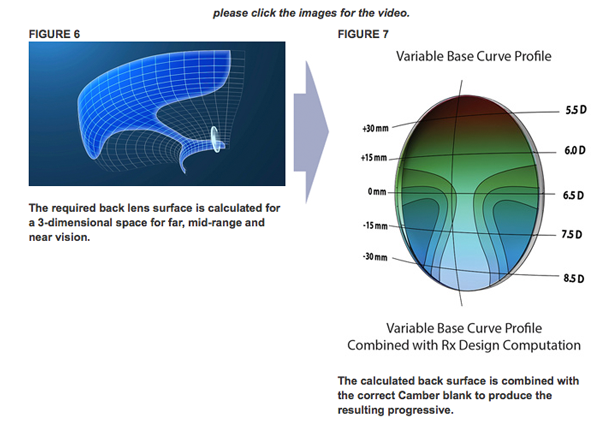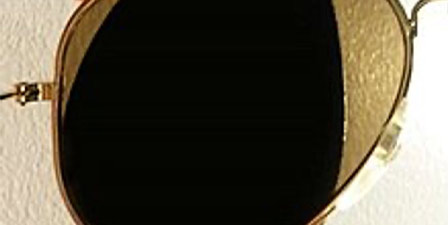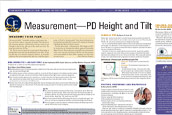Product Spotlight: Camber Technology—A Unique Patented Variable Base Curve Digital Progressive (reprint of CE with permission)
ISN'T ALL DIGITAL TECHNOLOGY/FREE-FORM BETTER?
Do you agree with the statement, "Free-form, i.e., digitally-compensated lenses produce more satisfied patients"? I know most do agree, because when I ask that question to those in attendance at my classes, almost all of them selling digital lenses say they agree. However, as many have experienced, results vary depending on how judiciously the free-form processes are applied. In fact, that range of free-form processing capability is what provides a good, better and best choice of lenses. While all digital lenses use compensation to improve peripheral vision, keep in mind that the more compensation is required, the less optimization is possible. That is to say, reducing the need to compensate expands the lens' personalization and optimization opportunities.
In cases where an overly flat base curve is chosen (for example, a low plus Rx in a large, flat retro frame), or an overly steep lens is chosen (for example, a -4.00D Rx in an 8-base sport frame), free-form compensation may be applied to improve peripheral vision. However, because the base curve of the chosen blank is not ideal for the power of the lens, more compensation is required, sometimes more than possible. Maintaining the "ideal" base curve reduces compensation requirements.
A NEW METHOD TO DELIVER VARIABLE BASE CURVES: CAMBER TECHNOLOGY
New Camber technology combines complex curves on both lens surfaces. The continuously changing, special front surface uses more traditional, flatter curves for distance and steeper curves for near, thereby providing the optically correct base curve throughout the lens.
FRONT SURFACE INNOVATION
Camber lenses have a continuously increasing front surface curvature that can be thought of as a "stacking of consecutive spheres." There are eight available base curves (0.5, 2, 3, 4, 5, 6, 7 and 8 base). Each of these comes from a successive section of a spiral-shaped curve, which is shaped almost like an elephant's trunk (Fig. 4). This means that the Camber front surface increases in base curve from top to bottom—lower diopter in the distance zone, higher in the reading zone. It might help to imagine an endless stack of discs with decreasing diameters and therefore increasing base curves. Here you see an example of a 6-base lens (Fig. 5). This "stacking of the spheres" is a totally new idea, unique to Camber lenses.
The variable front curve (white line, Fig. 5) has an "umbilic" corridor with a constant rate of power increase from top to bottom. In other words, a 6-base Camber blank is only 6.50D through the horizontal middle. The blank flattens toward the top to a 5.50D curve. As you go down, the curvature of the lens increases from a 6.50D curvature to 8.50D curvature. As a result, there is a total of about 3 diopters difference from top to bottom. In steeper base curves, the total increase is greater, due to the nature of the "Elephant's Trunk" curve (Fig. 4).
This patented, continuously increasing base curve is ideal for the increasing power profile of free-form progressive lenses.

DIGITALLY INDIVIDUALIZED BACK
When combined with a sophisticated back-surface digital design, both surfaces work together to accommodate an expanded Rx range, offer better cosmetics (flatter) for many prescriptions and deliver user-preferred near vision performance.
To produce Camber prescription lenses, cutting files are optimized using "Digital Ray-Path,” a lab calculation software designed by IOT (Indizen Optical Technologies S.I.). Considering prescription, frame and fitting requirements, Digital Ray-Path minimizes oblique aberrations, point by point, across the lens surface. Fig. 6 shows the 3D field of view assessed by the IOT calculation engine to determine the correct Camber lens blank and the rear surface design. The Camber design and Digital Ray-Path technology work together in a complementary way to maximize the benefit of the Camber variable base curve front surface.
Individualization parameters are merged with the Camber prescription design computation to become the guide for processing the back surface of the Camber lens. When the digital back surface combines with the unique Camber front surface, this forms the desired progressive prescription (Fig. 7). This delivers improved visual acuity for all distances and gaze directions.
WHAT ARE THE CHALLENGES OF CURRENT PROGRESSIVE LENS FORMS?
In a traditional progressive, the increased curvature of the addition produces increased magnification. That effect is lost in a SV front, back-surface progressive. As a result, a patient might say, "Reading is not as good." The effect of a free-form progressive is lesser because it doesn't have the same effective magnification ability. Magnification can improve the reading visual experience and increase visual acuity at near, compared to back-surface progressive designs.
Eye rotation is required to read through the near zone of a progressive lens. The flatter the lens' front surface, the more oblique the angle. In a back-surface digital progressive, increased digital compensation is required to correct for that off-center obliquity. This is one factor where the traditional progressive, with a steeper curve at near, was more optically correct.
Many people feel that by putting the progressive on the back, the patient is getting a wider corridor because it is closer to the eye. While this may be true, it is not without controversy. Some suggest that if the eye is closer to the corridor, the same eye rotation spans a shorter arc, so the corridor needs to be shorter. A shorter corridor produces more peripheral astigmatism than a longer corridor would have. A shorter corridor is also narrower, which is less desirable. Also, some designers feel that the distance saved by putting the progressive on the back is very small, if you consider that the entire distance we're talking about is from the front surface of the lens to the back.
Lastly, though it may be good to have the prescription close to the face; the downside is that in high plus, back surface progressives, it may be too close, which can interfere with comfort. An example is "lash crash"—where eyelashes touch the back surface of the lens. If it is significantly high plus, the lens may require a convex add, which reduces its cosmetic appeal and may even be impossible for the lab to fabricate.
Camber's front lens surface with variable base curve addresses these concerns. The higher curvature in the near zone provides increased magnification. It also allows the use of cosmetically desirable, flatter front curves in plus powers. It's interesting; sometimes looking back to fundamental optical principles is the most effective way to move forward.
DISCUSSION: WEARER TEST
IOT, in association with the University of Madrid, designed and conducted a double-blind wearer trial comparing a Camber finished lens with one processed from a single vision blank. Both used the same contemporary IOT back-surface progressive design technology. Both prescriptions were made from the same material, same central base curve, in the same frame, and worn for one week each. The only difference between the two pairs of eyewear was the lens blanks they were processed from: Camber versus single vision. Wearers and testers were unaware of which lens was which. After trying them both, wearers were then asked to compare lenses.
When asked, "Which lens do you prefer the most?" wearers preferred Camber 2 to 1. Regarding ease of adaptation, 8 of 10 reported that adaptation to Camber seemed easier. Nine of 10 reported better near vision. Considering all factors, 55 percent (a majority) found Camber better, 39 percent found it to be equal.
Wearer trials like this are not very common today because it is very tough to show significant differences in wearing experiences. Test subjects find it difficult to differentiate and express their preferences. Additionally, the trials are very expensive and time-consuming to perform. Therefore, these reported results are significant.
IS CAMBER SUGGESTING STEEPER BASE CURVES IN GENERAL?
No—while optically ideal base curves are steep, Camber lenses are flatter. Clearly, patients (and their opticians) accustomed to newer, flatter lenses, won't accept lenses with extra bulge and thickness. Prescription for prescription, the variable base curve Camber blank is, in fact, flatter than recommended traditional progressive lens curves. Fig. 8 compares a cross-sectional view of a +2.50 add lens on an equivalent 2.25D, 3.25D and 4.25D base curve. You can see that the Camber lenses are flatter. Typically, a flatter base curve would be chosen, resulting in a more appealing finished prescription.

WHICH FACTORS ARE IMPORTANT IN DISPENSING A PROGRESSIVE LENS DESIGN?
Critical: When delivering a finished progressive lens to a patient, the most important factor is not the work of the lens designer or the laboratory, but you—the dispenser. That's because the decisions you make to construct the finished product affect the patient's satisfaction. We assume the critical factors of a proper refraction (correct prescription, fitting height and PD measurements) have been done correctly. Of course, if these three items are not correct, it doesn't matter how good some of the other options might be. The eyewear will not be successful.
Important: These include base curve selection, progressive design, corridor length, primary uses and lens material. I often get asked, "Which progressive design is best?" The answer is not in the design, but rather in all the parameters required to build those glasses. That's what makes patients happy.
The design of the progressive, while important, is not any more significant than the other items in the list. One must weigh each to build the final lenses. For many people, lens material and its thinness and lightness may be of utmost importance toward a successful pair of glasses. Others may have very different demands.
Nice to have: I also believe that customizing or tailoring a prescription with the individual wearer's parameters is definitely of benefit. Judging by the number of offices that actually use position-of-wear measurements, it's clear that it's still a "nice to have," but first, the factors in the "critical" and "important" categories require mastery.
PATIENT BENEFITS
Finally, any lens' success, regardless of its attributes, depends on the benefits that it provides for both the patient and you, the ECP. Camber progressive lenses have been designed to use two surfaces rather than just one. The variable base curve front improves optimization possibilities. The steeper front curve in the reading zone eliminates peripheral blur while it delivers a wider reading area with an increased and appreciated magnification effect, all without the harsher distortion effects of traditional progressives. This design is automatically optimized and can be customized with position-of-wear measurements such as vertex, tilt and wrap. And because of the blank's variable base curve, the design calculation can use its computational "firepower" for optimization rather than compensation.
AVAILABILITY
Camber has a wide availability to suit all patients, including clear, Transitions Signature VII Gray and Brown, and NuPolar polarized. Materials include hard resin, polycarbonate, Trilogy Trivex, and 1.60 and 1.67 high index. Camber is available in the following base curves for a complete prescription range: 0.50, 2, 3, 4, 5, 6, 7 and 8D. NuPolar Trilogy and 1.74 (clear and Transitions) will be available in 2016.
CONCLUSION
Variable base curves, digitally-optimized and individually constructed, address a number of issues and produce better, more satisfying progressive lenses. Looking back to move forward, in this case, made a lot of sense.

Mark Mattison-Shupnick, ABOM, is currently director of education for Jobson Medical Information LLC, has more than 40 years of experience as an optician, was senior staff member of SOLA International and is a frequent lecturer and trainer.













